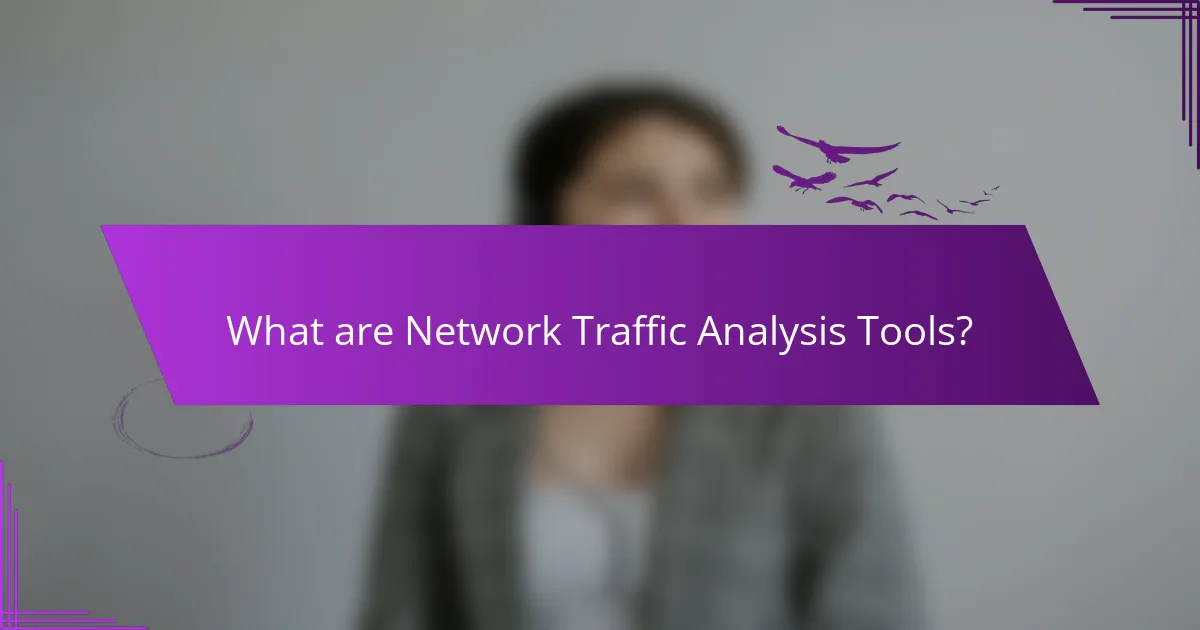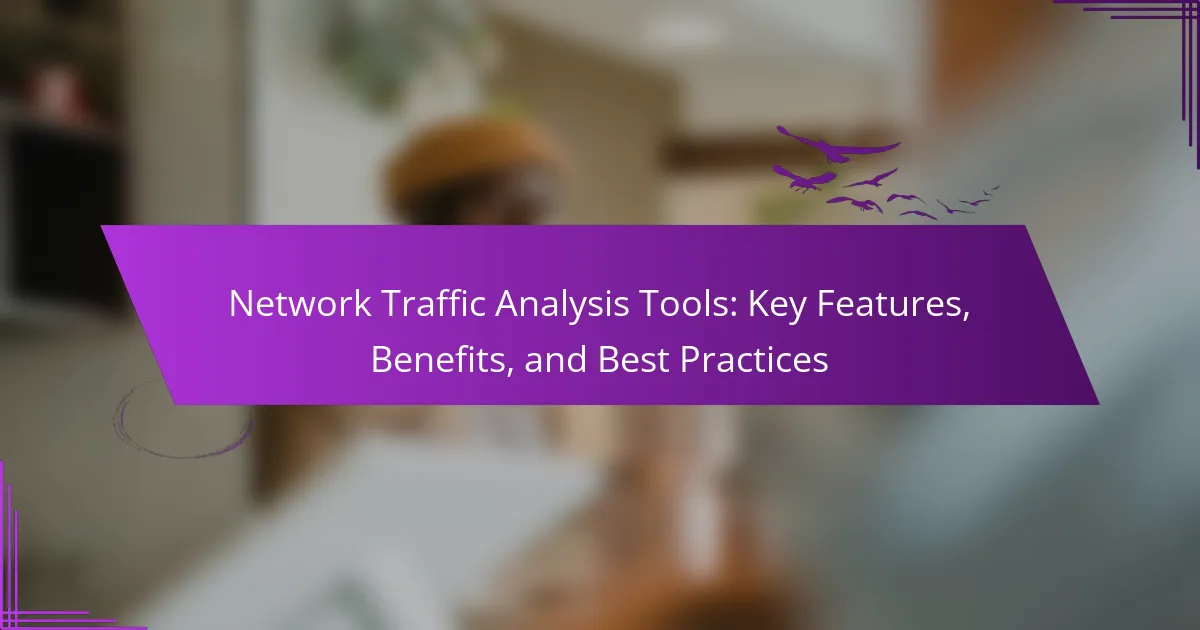
What are Network Traffic Analysis Tools?
Network traffic analysis tools are software applications used to monitor and analyze network traffic. They help in identifying performance issues, security threats, and compliance violations. These tools capture data packets traveling through a network. They analyze this data to provide insights into bandwidth usage and application performance. Common functionalities include packet sniffing, traffic visualization, and anomaly detection. Popular examples include Wireshark and SolarWinds. According to a report by MarketsandMarkets, the network traffic analysis market is expected to grow significantly, indicating the increasing importance of these tools in network management.
How do Network Traffic Analysis Tools function?
Network traffic analysis tools function by monitoring and analyzing data packets transmitted over a network. They capture network traffic in real-time or through historical data. These tools decode the packets to extract relevant information, such as source and destination IP addresses. They also identify protocols and applications involved in the communication.
Network traffic analysis tools provide insights into bandwidth usage and network performance. They help detect anomalies, security threats, and potential bottlenecks. Many tools use machine learning algorithms to enhance detection capabilities. They can generate reports and visualizations for easier interpretation of data.
According to a report by Gartner, effective network traffic analysis can reduce downtime by up to 50%. This demonstrates the critical role these tools play in maintaining network health and security.
What are the essential components of Network Traffic Analysis Tools?
The essential components of Network Traffic Analysis Tools include data capture, traffic analysis, visualization, and reporting. Data capture involves collecting packets from the network for inspection. Traffic analysis examines the captured data to identify patterns and anomalies. Visualization presents the analysis results in an understandable format, often through graphs and charts. Reporting generates summaries of the findings for stakeholders. These components work together to provide insights into network performance and security.
How do these components interact to analyze network traffic?
Network traffic analysis tools interact through data collection, processing, and visualization components. Data collection components capture packet information from the network. These components include hardware like network taps and software agents. Processing components analyze the captured data for anomalies and patterns. They utilize algorithms to identify trends and potential threats. Visualization components present the analyzed data in user-friendly formats. Dashboards and graphs help users interpret the information quickly. Together, these components enable comprehensive monitoring and management of network performance and security. This interaction allows for real-time insights into network behavior and issues.
What key features should you look for in Network Traffic Analysis Tools?
Key features to look for in Network Traffic Analysis Tools include real-time monitoring, deep packet inspection, and customizable dashboards. Real-time monitoring enables immediate detection of anomalies and threats. Deep packet inspection provides detailed insights into the data being transmitted across the network. Customizable dashboards allow users to tailor the display of metrics to their specific needs. Additionally, support for various protocols is essential for comprehensive analysis. Integration capabilities with other security tools enhance the tool’s effectiveness. Historical data analysis helps in identifying trends and patterns over time. Finally, user-friendly interfaces ensure ease of use for network administrators. These features collectively improve network security and performance.
What functionalities enhance the effectiveness of Network Traffic Analysis Tools?
Network Traffic Analysis Tools are enhanced by functionalities such as real-time monitoring, packet analysis, and anomaly detection. Real-time monitoring allows for immediate visibility into network performance and issues. Packet analysis enables detailed examination of data packets for troubleshooting and optimization. Anomaly detection identifies unusual patterns that may indicate security threats or network malfunctions. Additionally, reporting and visualization tools facilitate easier interpretation of data. Integration with other security tools enhances overall network defense. These functionalities collectively improve the effectiveness of Network Traffic Analysis Tools.
How do user interfaces impact the usability of Network Traffic Analysis Tools?
User interfaces significantly impact the usability of Network Traffic Analysis Tools. A well-designed user interface enhances user experience by making navigation intuitive. It allows users to access essential features quickly, reducing the time needed for analysis. Clarity in visual representation of data aids in faster decision-making. Poor interface design can lead to user frustration and errors in data interpretation. Research indicates that tools with streamlined interfaces improve user efficiency by up to 30%. Effective interfaces support customization, enabling users to tailor views according to specific needs. Overall, user interfaces play a crucial role in determining how effectively users can leverage network traffic analysis tools.
What benefits do Network Traffic Analysis Tools provide?
Network Traffic Analysis Tools provide enhanced visibility into network performance and security. They monitor data flow and identify bottlenecks. These tools help detect unauthorized access and potential security threats. They can analyze bandwidth usage, optimizing resource allocation. Additionally, they facilitate troubleshooting by pinpointing issues quickly. Many tools offer real-time reporting for timely decision-making. According to a study by Gartner, organizations using these tools can reduce downtime by up to 50%. This efficiency leads to improved overall network reliability and user satisfaction.
How do Network Traffic Analysis Tools improve network security?
Network traffic analysis tools enhance network security by monitoring and analyzing data packets traversing a network. They detect unusual traffic patterns indicative of potential threats. These tools provide real-time alerts for suspicious activities, enabling swift responses to incidents. They also facilitate forensic analysis by logging traffic data for future investigations. By identifying vulnerabilities, these tools help in fortifying network defenses. According to a 2021 study by Cybersecurity Ventures, organizations using network traffic analysis tools reduce security breach incidents by up to 50%. This underscores their critical role in maintaining robust network security.
What role do Network Traffic Analysis Tools play in performance optimization?
Network Traffic Analysis Tools play a critical role in performance optimization by monitoring and analyzing data flow across networks. They help identify bottlenecks and latency issues in real-time. These tools provide insights into bandwidth usage and application performance. By analyzing traffic patterns, they enable network administrators to make informed decisions. This leads to improved resource allocation and enhanced overall network efficiency. According to a study by Gartner, organizations that utilize these tools can reduce network-related downtime by up to 30%. This demonstrates their effectiveness in maintaining optimal network performance.
How can you effectively implement Network Traffic Analysis Tools?
To effectively implement Network Traffic Analysis Tools, first select the appropriate tool based on your network’s needs. Identify key features such as real-time monitoring and reporting capabilities. Ensure compatibility with existing network infrastructure for seamless integration. Configure the tool to capture relevant traffic data and set up alerts for unusual activities. Regularly review and analyze the collected data to identify trends and issues. Train staff on using the tool effectively to maximize its benefits. According to a study by Gartner, organizations that utilize network analysis tools can reduce incident response times by up to 50%.
What best practices should be followed when using Network Traffic Analysis Tools?
Best practices for using Network Traffic Analysis Tools include defining clear objectives for analysis. Establish specific goals to guide the monitoring process. Regularly update the tools to ensure access to the latest features and security patches. Utilize filters to focus on relevant data, reducing noise in the analysis. Implement proper access controls to safeguard sensitive information. Conduct routine audits of network traffic for anomalies. Document findings and actions taken for future reference. Collaborate with stakeholders to align network analysis with business needs. These practices enhance the efficiency and effectiveness of network traffic analysis.
What common challenges might arise during implementation?
Common challenges during implementation of network traffic analysis tools include integration issues, user resistance, and data accuracy. Integration issues can arise when the tool does not seamlessly connect with existing systems. User resistance may occur due to a lack of training or understanding of the tool’s benefits. Data accuracy can be compromised if the tool is not configured correctly or if there are inconsistencies in the data sources. Additionally, scalability challenges may emerge as network demands grow. These challenges can hinder effective analysis and lead to suboptimal performance of the tools.
What are the most popular Network Traffic Analysis Tools available today?
The most popular Network Traffic Analysis Tools available today include Wireshark, SolarWinds Network Performance Monitor, and PRTG Network Monitor. Wireshark is widely used for packet analysis and is open-source. SolarWinds Network Performance Monitor provides real-time network insights and performance metrics. PRTG Network Monitor offers comprehensive monitoring capabilities for bandwidth usage and network health. These tools are favored for their robust features and user-friendly interfaces.
What unique attributes do different Network Traffic Analysis Tools offer?
Different Network Traffic Analysis Tools offer unique attributes tailored to specific needs. For example, some tools excel in real-time monitoring of network performance. Others provide advanced threat detection through machine learning algorithms. Certain tools focus on deep packet inspection for detailed traffic analysis. Some tools integrate with other security systems for enhanced protection. Additionally, user-friendly dashboards are a common unique attribute, simplifying data visualization. Other tools may offer customizable reporting features to meet specific organizational requirements. These unique attributes help organizations select the right tool for their network analysis needs.
How do these tools compare in terms of pricing and features?
Pricing and features of network traffic analysis tools vary significantly. Some tools offer basic functionalities at lower prices, while others provide advanced features at a premium cost. For example, basic tools may start around $50 per month, while comprehensive solutions can exceed $1,000 per month. Features often include real-time monitoring, reporting capabilities, and alert systems. Advanced tools typically offer deeper analytics, machine learning integration, and enhanced security features. According to industry reports, organizations must assess their specific needs to choose the right tool that balances pricing with essential features.
What troubleshooting tips can help when using Network Traffic Analysis Tools?
To troubleshoot effectively when using Network Traffic Analysis Tools, start by ensuring that the tool is properly configured. Verify that the correct network interfaces are selected for monitoring. Next, check for any software updates that may enhance functionality or fix bugs. Review the tool’s documentation for specific troubleshooting guidelines. If issues persist, analyze the captured traffic for anomalies or patterns that could indicate problems. Restart the tool or the device it is running on to clear temporary glitches. Utilize community forums or vendor support for additional insights or solutions. These steps are commonly recommended practices in network management to ensure optimal performance.
Network Traffic Analysis Tools are software applications designed to monitor and analyze network traffic, identifying performance issues, security threats, and compliance violations. This article explores essential components, functionalities, and key features of these tools, highlighting their role in enhancing network performance and security. It also discusses best practices for implementation, common challenges, and comparisons of popular tools available in the market. By understanding the benefits and effective usage of Network Traffic Analysis Tools, organizations can significantly improve their network management and reduce downtime.
